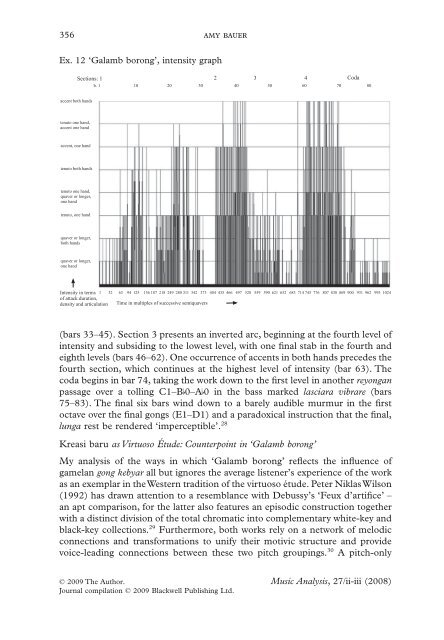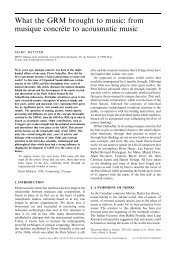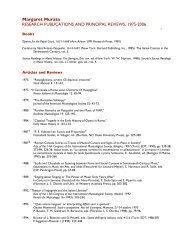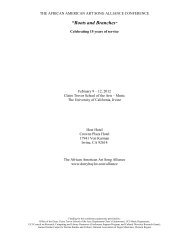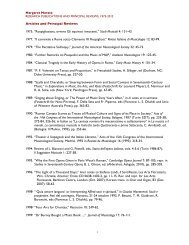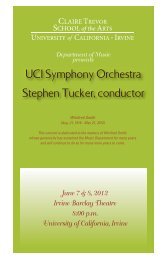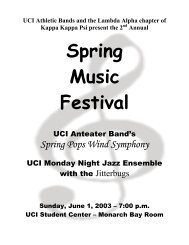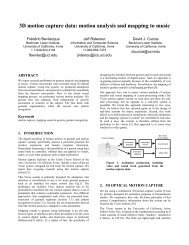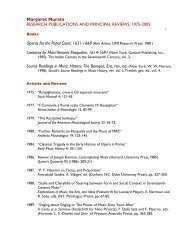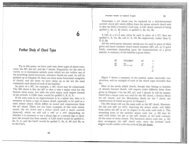amy bauer The Other of the Exotic: Balinese Music as Grammatical ...
amy bauer The Other of the Exotic: Balinese Music as Grammatical ...
amy bauer The Other of the Exotic: Balinese Music as Grammatical ...
You also want an ePaper? Increase the reach of your titles
YUMPU automatically turns print PDFs into web optimized ePapers that Google loves.
356 <strong>amy</strong> <strong>bauer</strong><br />
Ex. 12 ‘Galamb borong’, intensity graph<br />
Sections: 1 2 3 4 Coda<br />
b. 1 10 20 30 40 50 60 70 80<br />
accent both hands<br />
tenuto one hand,<br />
accent one hand<br />
accent, one hand<br />
tenuto both hands<br />
tenuto one hand,<br />
quaver or longer,<br />
one hand<br />
tenuto, one hand<br />
quaver or longer,<br />
both hands<br />
quaver or longer,<br />
one hand<br />
Intensity in terms 1 32 63 94 125 156 187 218 249 280 311 342 373 404 435 466 497 528 559 590 621 652 683 714 745 776 807 838 869 900 931 962 993 1024<br />
<strong>of</strong> attack duration,<br />
density and articulation Time in multiples <strong>of</strong> successive semiquavers<br />
(bars 33–45). Section 3 presents an inverted arc, beginning at <strong>the</strong> fourth level <strong>of</strong><br />
intensity and subsiding to <strong>the</strong> lowest level, with one final stab in <strong>the</strong> fourth and<br />
eighth levels (bars 46–62). One occurrence <strong>of</strong> accents in both hands precedes <strong>the</strong><br />
fourth section, which continues at <strong>the</strong> highest level <strong>of</strong> intensity (bar 63). <strong>The</strong><br />
coda begins in bar 74, taking <strong>the</strong> work down to <strong>the</strong> first level in ano<strong>the</strong>r reyongan<br />
p<strong>as</strong>sage over a tolling C1–B♭0–A♭0 in <strong>the</strong> b<strong>as</strong>s marked l<strong>as</strong>ciara vibrare (bars<br />
75–83). <strong>The</strong> final six bars wind down to a barely audible murmur in <strong>the</strong> first<br />
octave over <strong>the</strong> final gongs (E1–D1) and a paradoxical instruction that <strong>the</strong> final,<br />
lunga rest be rendered ‘imperceptible’. 28<br />
Kre<strong>as</strong>i baru <strong>as</strong> Virtuoso Étude: Counterpoint in ‘Galamb borong’<br />
My analysis <strong>of</strong> <strong>the</strong> ways in which ‘Galamb borong’ reflects <strong>the</strong> influence <strong>of</strong><br />
gamelan gong kebyar all but ignores <strong>the</strong> average listener’s experience <strong>of</strong> <strong>the</strong> work<br />
<strong>as</strong> an exemplar in <strong>the</strong>Western tradition <strong>of</strong> <strong>the</strong> virtuoso étude. Peter Nikl<strong>as</strong>Wilson<br />
(1992) h<strong>as</strong> drawn attention to a resemblance with Debussy’s ‘Feux d’artifice’ –<br />
an apt comparison, for <strong>the</strong> latter also features an episodic construction toge<strong>the</strong>r<br />
with a distinct division <strong>of</strong> <strong>the</strong> total chromatic into complementary white-key and<br />
black-key collections. 29 Fur<strong>the</strong>rmore, both works rely on a network <strong>of</strong> melodic<br />
connections and transformations to unify <strong>the</strong>ir motivic structure and provide<br />
voice-leading connections between <strong>the</strong>se two pitch groupings. 30 A pitch-only<br />
© 2009 <strong>The</strong> Author.<br />
Journal compilation © 2009 Blackwell Publishing Ltd.<br />
<strong>Music</strong> Analysis, 27/ii-iii (2008)


